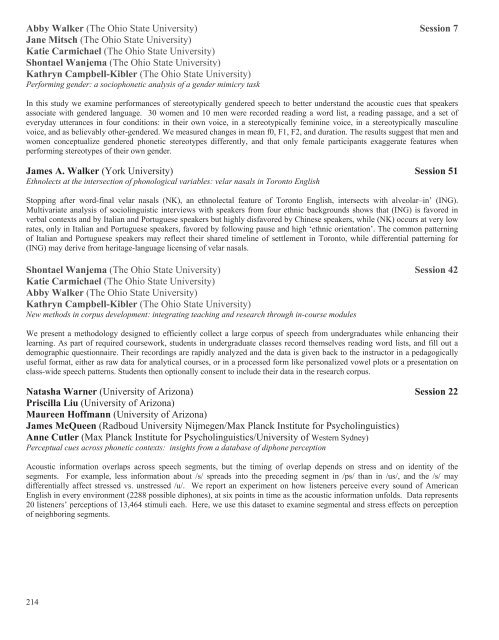here - Linguistic Society of America
here - Linguistic Society of America
here - Linguistic Society of America
Create successful ePaper yourself
Turn your PDF publications into a flip-book with our unique Google optimized e-Paper software.
Abby Walker (The Ohio State University) Session 7Jane Mitsch (The Ohio State University)Katie Carmichael (The Ohio State University)Shontael Wanjema (The Ohio State University)Kathryn Campbell-Kibler (The Ohio State University)Performing gender: a sociophonetic analysis <strong>of</strong> a gender mimicry taskIn this study we examine performances <strong>of</strong> stereotypically gendered speech to better understand the acoustic cues that speakersassociate with gendered language. 30 women and 10 men were recorded reading a word list, a reading passage, and a set <strong>of</strong>everyday utterances in four conditions: in their own voice, in a stereotypically feminine voice, in a stereotypically masculinevoice, and as believably other-gendered. We measured changes in mean f0, F1, F2, and duration. The results suggest that men andwomen conceptualize gendered phonetic stereotypes differently, and that only female participants exaggerate features whenperforming stereotypes <strong>of</strong> their own gender.James A. Walker (York University) Session 51Ethnolects at the intersection <strong>of</strong> phonological variables: velar nasals in Toronto EnglishStopping after word-final velar nasals (NK), an ethnolectal feature <strong>of</strong> Toronto English, intersects with alveolar–in’ (ING).Multivariate analysis <strong>of</strong> sociolinguistic interviews with speakers from four ethnic backgrounds shows that (ING) is favored inverbal contexts and by Italian and Portuguese speakers but highly disfavored by Chinese speakers, while (NK) occurs at very lowrates, only in Italian and Portuguese speakers, favored by following pause and high ‘ethnic orientation’. The common patterning<strong>of</strong> Italian and Portuguese speakers may reflect their shared timeline <strong>of</strong> settlement in Toronto, while differential patterning for(ING) may derive from heritage-language licensing <strong>of</strong> velar nasals.Shontael Wanjema (The Ohio State University) Session 42Katie Carmichael (The Ohio State University)Abby Walker (The Ohio State University)Kathryn Campbell-Kibler (The Ohio State University)New methods in corpus development: integrating teaching and research through in-course modulesWe present a methodology designed to efficiently collect a large corpus <strong>of</strong> speech from undergraduates while enhancing theirlearning. As part <strong>of</strong> required coursework, students in undergraduate classes record themselves reading word lists, and fill out ademographic questionnaire. Their recordings are rapidly analyzed and the data is given back to the instructor in a pedagogicallyuseful format, either as raw data for analytical courses, or in a processed form like personalized vowel plots or a presentation onclass-wide speech patterns. Students then optionally consent to include their data in the research corpus.Natasha Warner (University <strong>of</strong> Arizona) Session 22Priscilla Liu (University <strong>of</strong> Arizona)Maureen H<strong>of</strong>fmann (University <strong>of</strong> Arizona)James McQueen (Radboud University Nijmegen/Max Planck Institute for Psycholinguistics)Anne Cutler (Max Planck Institute for Psycholinguistics/University <strong>of</strong> Western Sydney)Perceptual cues across phonetic contexts: insights from a database <strong>of</strong> diphone perceptionAcoustic information overlaps across speech segments, but the timing <strong>of</strong> overlap depends on stress and on identity <strong>of</strong> thesegments. For example, less information about /s/ spreads into the preceding segment in /ps/ than in /us/, and the /s/ maydifferentially affect stressed vs. unstressed /u/. We report an experiment on how listeners perceive every sound <strong>of</strong> <strong>America</strong>nEnglish in every environment (2288 possible diphones), at six points in time as the acoustic information unfolds. Data represents20 listeners’ perceptions <strong>of</strong> 13,464 stimuli each. Here, we use this dataset to examine segmental and stress effects on perception<strong>of</strong> neighboring segments.214
















